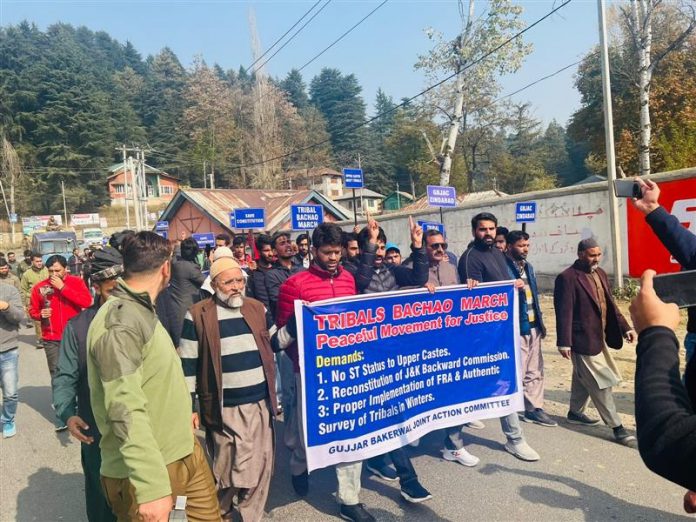Members of the Gujjar Bakarwal community in Jammu and Kashmir are on a protest march from Kupwara to Jammu against the government of India’s proposal to include Pahari people into the ST category.
Afnan Habib | TwoCircles.net
SRINAGAR (JAMMU AND KASHMIR) — Scores of Gujjar and Bakerwal people in Jammu and Kashmir are currently on a protest march on foot in the Union Territory against the government of India’s decision to include non-Scheduled Tribe (ST) people into the ST category. Gujjars and Bakerwals are the ethnic tribals of the region and fall into the ST category.
The march, organised by the Gujjar Bakarwal Joint Action Committee (GBJAC), started in Kupwara on November 4 and is aimed to cross several districts of the UT and raise awareness among the nomadic people about the repercussions of the move. The march will end in Kathua, Jammu.
A primary organization for ST communities in J&K, All Jammu and Kashmir Gujjar Bakerwal Co-ordination Committee (AJKGBCC), has urged the ST communities to “display black flags on their homes, wear black badges, and post images and videos on social media.”
“To register our protest against the move of the government to grant ST status to Pahari-speaking people, who belong to upper castes of society, a boycott call was announced on November 10 by All J&K Gujjar Bakerwal Co-ordination Committee (AJKGBCC),” Anwar Chowdhary, its convener, said during a press conference at Jammu.
Why are Gujjar-Bakerwals angry?
The centre’s decision to grant ST status to Paharis, and other groups like the “Paddari tribe,” “Kolis,” and “Gadda Brahmans” has drawn the ire of the Gujjar-Bakerwal community, who are the third largest ethnic group in Jammu Kashmir, after Kashmiris and Dogras. The tribal group’s contention is that the inclusion of these groups into the ST category is not justified as “these groups don’t fit the criteria to fall into the ST category and upper castes can’t be tribals.” They contend that opportunities for education and employment may be lost due to the inclusion of Paharis and other castes in the ST category. They fear that if Paharis are given the ST status, they will have to compete for jobs, scholarships, and other benefits under the category that was previously their domain.
The Pahari ethnic group, a linguistic minority in J&K that includes both Hindus and Muslims, was approved for incorporation on the ST list along with the “Paddari tribe,” “Kolis,” and “Gadda Brahmans” by the National Commission for Scheduled Tribes (NCST). The Commission for Socially and Educationally Backward Classes, led by Justice GD Sharma (retd), had recommended reservation to Pahari, Paddari and Koli as well as Gadda Brahman. With a population of nearly 11 lakh, Paharis mainly reside in the Pir Panjal region, which includes the districts of Poonch, Rajouri and Reasi.
Union Home Minister Amit Shah, during a rally in Rajouri last month, announced the plan to grant the ST status to the Pahari community. Shah’s rallies in the Rajouri and Baramulla districts of J&K UT saw massive attendance of people from t the Pahari community. His announcement was welcomed by the Pahari community but infuriated the Gujjars. Interestingly, nine seats were reserved for the STs for the first time by the Delimitation Commission earlier this year.
‘March to defend rights of tribals’
To protest against the move, on November 4 several Gujjar leaders and activists started a 500-kilometre protest march on foot from Kupwara, planning to visit all 20 districts of Jammu and Kashmir. The march, aimed at defending the rights of the tribals of Jammu and Kashmir, has entered its 13th day and will end at Lakhanpur in Kathua District. They are visiting tribal communities to warn locals about the inclusion of upper castes in scheduled tribes and how this will affect their future.
Talking to TwoCircles.net, Haji Mohammad Yousaf, Chairman of the Gujjar Bakerwal Joint Action Committee (GBJAC), said that the communities that are being included do not fulfil the criteria to be listed under the ST. “The Gujjar-Bakarwals are out on the roads right now. We were granted the 10% quota because of our nomadic lifestyle and the subpar amenities. It is intolerable that the government is now including members of the upper castes in it,” Yousaf said.
While denouncing the GD Sharma Commission report, Talib Hussain, a youth leader and the chief spokesperson of the GBJAC told TwoCircles.net that “the government’s decision to include the upper classes in the ST list for political benefits is unacceptable.”
Demanding the reconstitution of the Jammu and Kashmir Backward Commission and the proper implementation of the Forest Rights Act in J&K, Hussian said that tribals were already facing an identity crisis across the country. “Now, including communities such as ‘Gadda Brahmans,’ ‘Kolis,’ and ‘Paddari Rajputs’ under the ST list has added to their insecurities,” he said.
With a population of over 16 lakh, Gujjar and Bakerwals have influence in several Assembly and Lok Sabha constituencies. With the centre wooing Paharis and other communities by including them in the ST list, Gujjar leaders contend that by doing this they (Centre) will lose the support of a large number of Gujjar-Bakerwals.
Guftar Choudhary, one of the leaders heading the ‘Tribals Bachao March’ was quoted by The Tribune as saying, “Gujjars and Bakarwals are over 16 lakh in number in J&K. If the Central Government believes it will get the support of other communities, it should keep in mind that only 2-3 lakh voters are being targeted. They will lose the support of Gujjars and Bakarwals.”
Afnan Habib is a freelance journalist based in Srinagar, Jammu and Kashmir. He tweets @afnanhabib_


